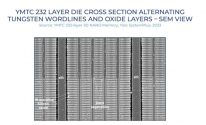Two years? What does it mean? YMTC's 232L TLC chips and 232L QLC chips went into market earlier than any other companies.
TechInsights said that the Micron 2xxL 3D-NAND, although announced to have entered volume production before, showed up in the market AFTER YMTC's 2xxL. YMTC had the first 2xxL 3D-NAND in the market.Both Micron & Hynix had >10K wpm of 2xxL 3D-NAND as far back as 1Q22. No one considered that as the 'N' node. YMTC was ramping its 232L close to 10K wpm then last October's US BIS restriction came in. Since then, its 232L output has been very limited. YMTC's 100K wpm capacity is split between 128L & 64L 3D-NAND at the moment. Their 'N' node is considerred to be 128L node.
The Big4 of 3D-NAND all have significant volume at 176L nodes and above. This is probably why the comment on YMTC being '2yrs behind'.
The last I checked, Micron is already running both their 232L & 276L 3D-NAND at monthly volume at each nodes higher than YMTC ever had with their 232L. If we consider 10-30K wpm as significant volume, then YMTC is technically behind Micron by ~2-3 nodes. So I think the article claiming '2 years behind' is being kind. Micron is leading the 3D-NAND technology race, but their over volume is mere 50% larger than YMTC at the moment, so they don't make much impact on the over-all scheme of thing in the 3D-NAND market either.
"Now, by skipping the release of a 176-layer solution, YMTC has jumped directly into developing and mass-producing the 232-layer Xtacking3.0, which is the first 200+ layer solution we’ve found on the market. It’s the most advanced product with the highest bit density and the highest number of layers ever in the 3D NAND field.
Given that Micron just started to ship 232L NAND SSD for PCs and laptops, Samsung has successfully developed 232L custom samples, and SK Hynix’s 238L development is ongoing now, YMTC’s new 232L Xtacking3.0 TLC technology is a disruptive one and it may lead the future of 3D NAND technology."
Claiming that YMTC is two years behind technology wise is bollocks.



